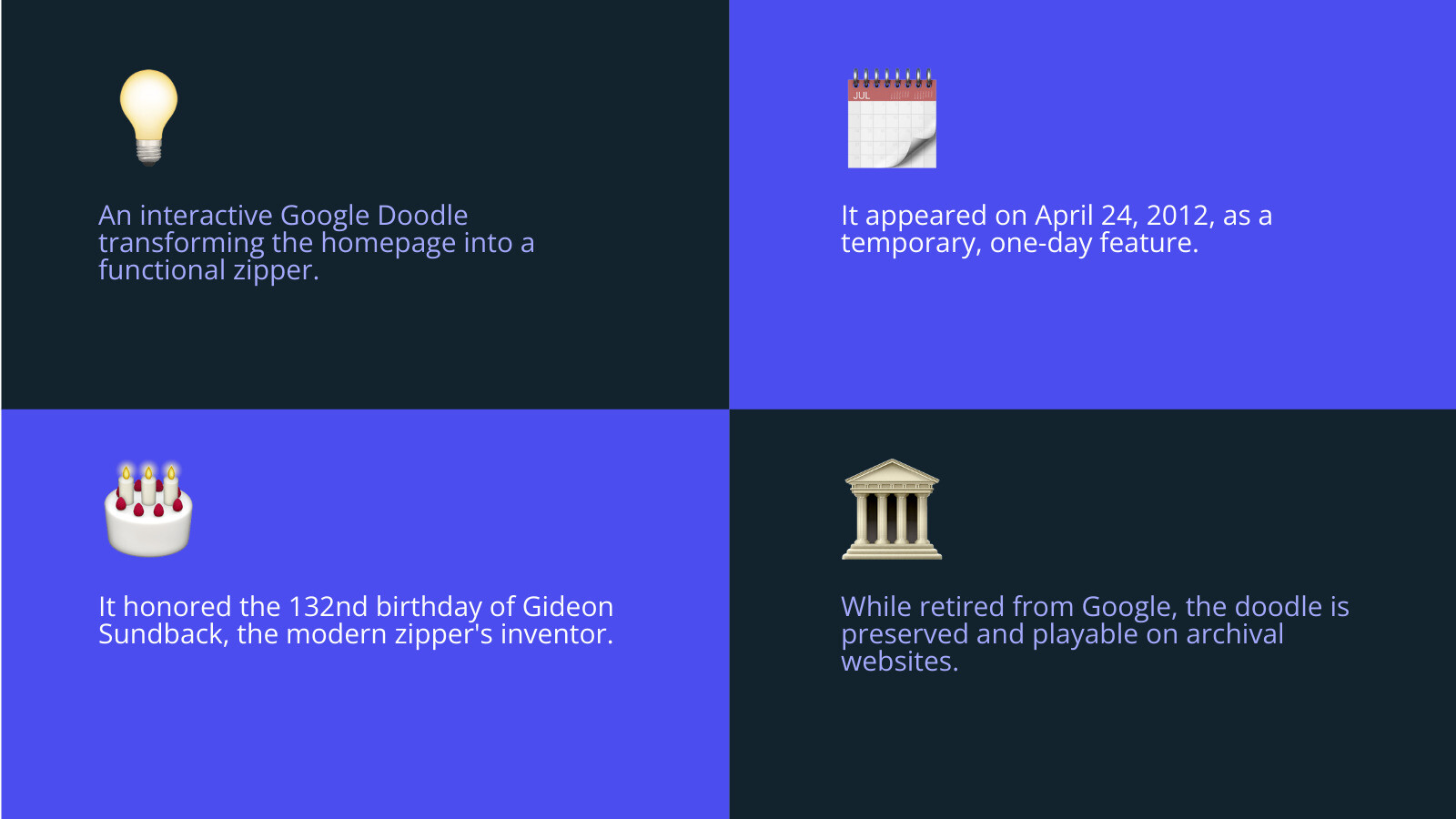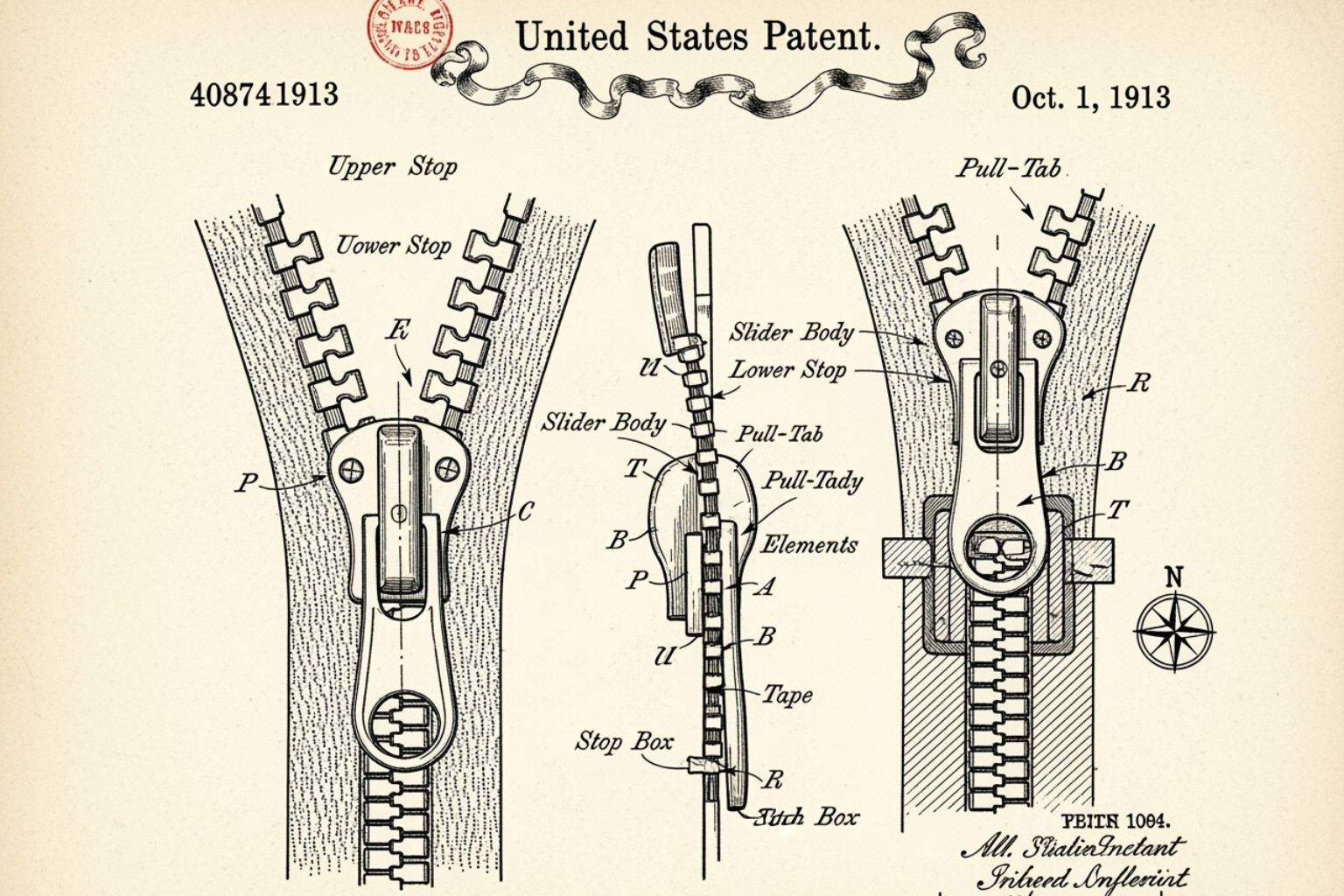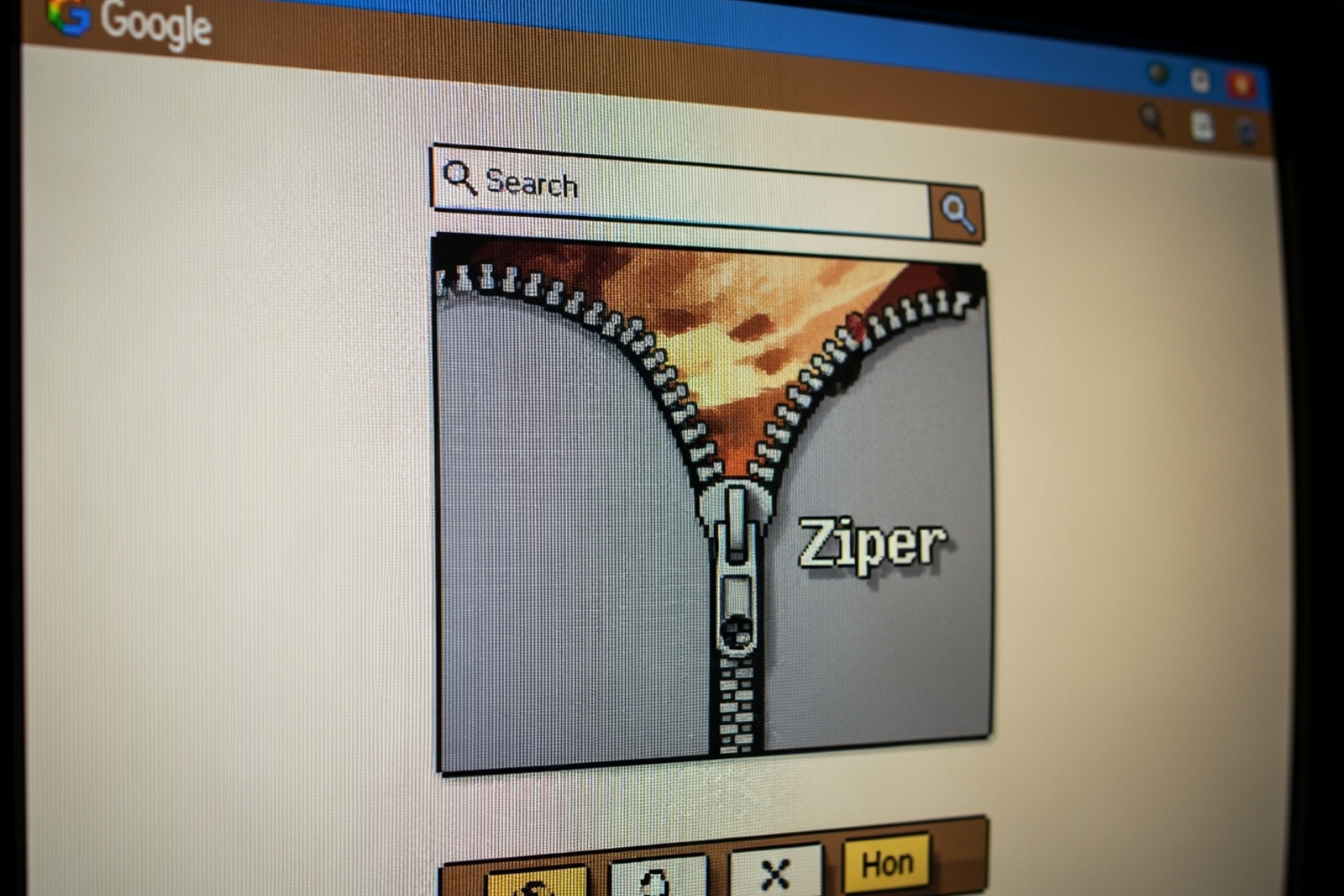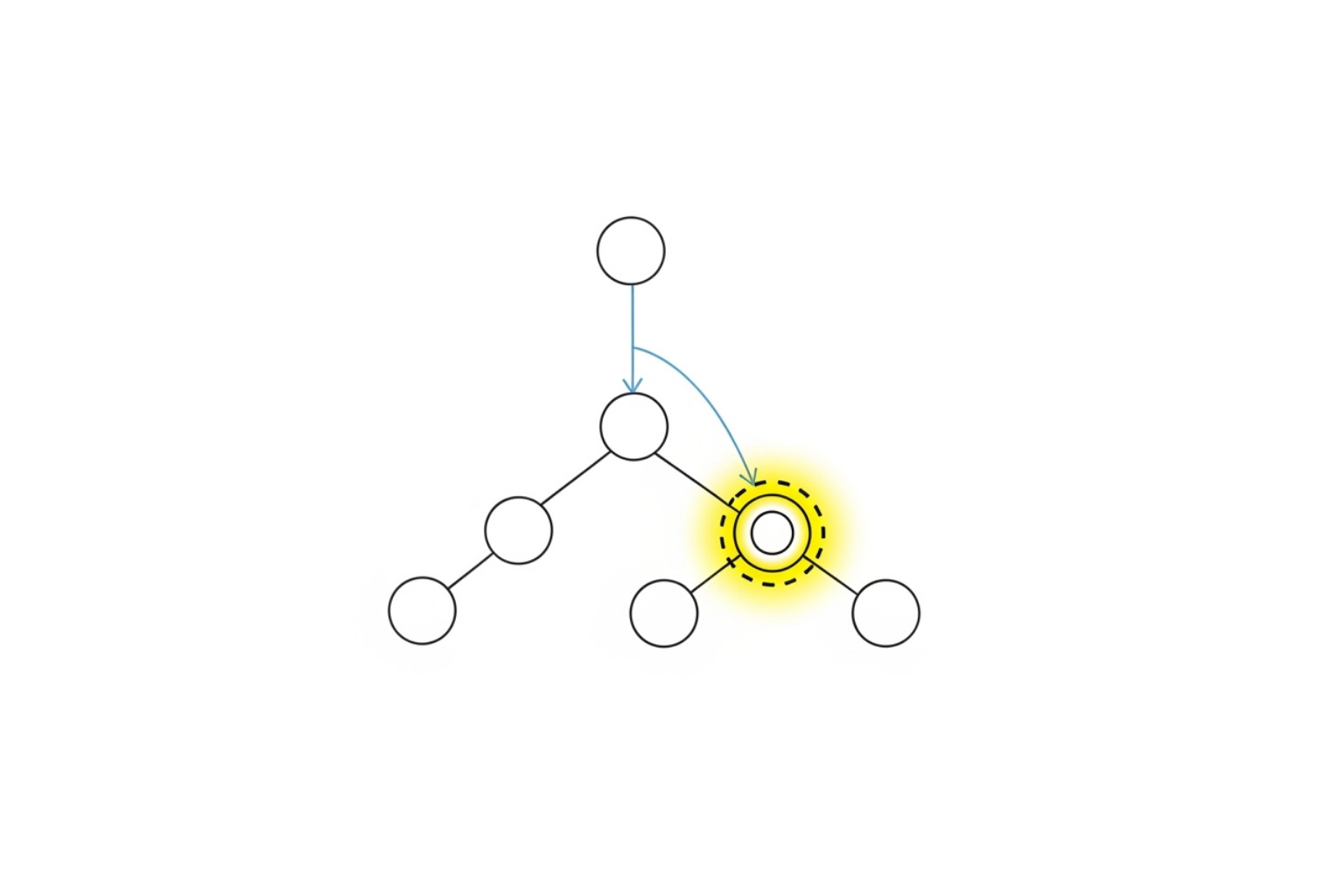Why the Google Zipper Became an Unforgettable Digital Moment
The Google zipper was a one-day interactive doodle that appeared on Google’s homepage on April 24, 2012. This playful Easter egg allowed users to literally “unzip” the Google interface by clicking and dragging a zipper down the middle of the page, revealing search results underneath.
Quick Facts About Google Zipper:
- What it was: An interactive homepage doodle featuring a functional zipper
- When it appeared: April 24, 2012 (one day only)
- Who it honored: Gideon Sundback, inventor of the modern zipper
- Why it was special: Users could drag the zipper to “unzip” the Google page
- Where to find it now: Preserved on archival sites like elgooG
This clever tribute celebrated the 132nd birthday of Gideon Sundback, the Swedish-American engineer who perfected the zipper design we still use today. The doodle transformed a routine Google search into an engaging experience that delighted millions of users worldwide.
As one Google employee noted about their culture of innovation: “It’s no secret that we have fun finding innovative solutions to big problems.” The Google zipper perfectly captured this spirit of playful creativity.
While the original doodle lasted just one day, it became one of Google’s most memorable Easter eggs. The interactive experience showcased how simple web technologies could create moments of genuine surprise and joy for users browsing the internet.

Step 1: Unzipping the Experience – What Was the Google Zipper?
Picture this: you visit Google to start your day, expecting the familiar, clean white homepage, but instead, you find something completely unexpected. A giant zipper is running straight down the middle of your screen!
That’s exactly what millions of users experienced on April 24, 2012, when the Google zipper made its memorable debut. This wasn’t just another static doodle to glance at and move on from. This was something entirely different—an interactive experience that invited you to actually play with the Google homepage itself.

The magic happened when you clicked on the zipper pull and started dragging it downward. As you moved your mouse, the Google zipper would smoothly open, splitting the entire homepage right down the middle. Underneath, like a delightful surprise, were your regular search results waiting to be found.
It was one of those rare internet moments that made you smile. The simple act of “unzipping” a webpage felt both familiar and completely novel. You knew how zippers worked in real life, but seeing one function on a computer screen was pure digital magic.
This playful tribute was created to honor the 132nd birthday of Gideon Sundback, the Swedish-American engineer who perfected the modern zipper. The team at Google transformed what could have been a simple historical note into something genuinely fun and engaging.
The Google zipper proved that the smallest touches can create the biggest impact. It turned a routine search into a moment of delight, showing how thoughtful design can bring unexpected joy to our daily digital interactions—a core principle of digital wellness.
The Tech Behind the Fun: How the Google Zipper Worked
You might be curious about how Google’s developers managed to create such a realistic zipper effect right in your web browser. The technology behind the Google zipper was actually quite clever, especially for 2012 web standards.
The magic started with dynamic HTML – the foundation that allowed different parts of the page to move and change in real-time. When you clicked on that zipper pull, JavaScript code immediately detected your mouse movement and tracked exactly where you were dragging.
CSS animations handled the visual magic, controlling how smoothly the zipper opened and how realistically the two halves of the page separated. The developers had to make sure the zipper teeth looked like they were actually coming apart, just like a real zipper on your favorite jacket.
The most impressive part was how responsive the whole experience felt. As you dragged the zipper down, the page split followed your mouse perfectly, creating that satisfying feeling of actually unzipping something. The smooth unzipping effect made it feel tactile and real, even though you were just moving a cursor around your screen.
This wasn’t just a simple animation playing on loop. The Google zipper responded to your actions, making each person’s experience unique based on how fast or slow they dragged, and whether they went all the way down or stopped partway through.
Looking back, it was an early example of how web design could break free from static pages and create truly interactive experiences. The Google zipper showed that even the most familiar websites could surprise us, turning an ordinary search into something memorable and fun.
Step 2: The Man Behind the Fastener – Why It Was Created
The Google zipper wasn’t just a playful digital experiment created on a whim. Like many of Google’s most beloved doodles, this interactive masterpiece had a meaningful purpose: to celebrate a remarkable inventor whose creation touches our lives every single day.

On April 24, 2012, Google chose to honor Gideon Sundback on what would have been his 132nd birthday. Born on that same date in 1880, this Swedish-American electrical engineer transformed a frustrating, unreliable contraption into the smooth-operating zipper we rely on today.
Now, Sundback didn’t actually invent the slide fastener from scratch. That credit goes to Whitcomb L. Judson, who patented his “automatic closing device” back in 1893. But here’s the thing – those early fasteners were honestly pretty terrible! They had a nasty habit of popping open at the worst possible moments, and some even had sharp edges that could tear your clothes. Not exactly what you’d want on your favorite jacket.
This is where Sundback’s engineering genius really shone. He refused to accept “good enough.” In 1913, he developed his “Hookless Fastener No. 2” – a design featuring interlocking teeth that actually stayed closed when you needed them to.
But Sundback wasn’t done perfecting his creation. By 1917, he had refined his design even further, creating the “separable fastener” with those distinctive scoop-shaped teeth and a slider mechanism that worked reliably every time. The first major use of this improved fastener? Money belts for sailors during World War I – because when you’re at sea, you definitely need your belongings to stay secure!
Here’s a fun fact that might surprise you: the word “zipper” wasn’t even Sundback’s idea! The B.F. Goodrich Company came up with that catchy name for their rubber boots that used his fastener technology. They liked how it sounded when you zipped it up and down. The name was so perfect that it stuck, and now we can’t imagine calling it anything else.
Google’s tribute to Sundback was a beautiful way to acknowledge how one person’s dedication to improvement created something we use countless times every day. You can learn More about the zipper’s inventor and find how his meticulous attention to detail changed the world in the most practical way possible.
Step 3: The Legacy of the Google Zipper and Where to Find It
Like many memorable digital moments, the Google zipper was a temporary feature. This delightful interactive doodle graced Google’s homepage for just one day before disappearing into the archives. There’s something special about its brief appearance; the fleeting nature of the experience made it all the more memorable for those who finded it.

Google often designs its doodles as one-day events to keep the homepage fresh and celebrate timely occasions. There are also practical reasons for retiring interactive features like the Google zipper. As web technology evolves, maintaining older, complex animations across all new devices and browsers can be challenging. Google prioritizes a smooth, fast search experience for all users, which sometimes means retiring these beloved creations.
But here’s the wonderful news for fans of internet history: the web has a long memory! While you won’t find the Google zipper on the live homepage anymore, dedicated archival websites have lovingly preserved this piece of digital art. The most popular of these is elgooG—Google spelled backward.
This site serves as a treasure trove of interactive nostalgia, allowing you to experience the simple joy of unzipping Google whenever you need a smile. You can Play with the Google Zipper today and refind the satisfying animation that charmed millions back in 2012.
More Than Just a Zipper: Its Place in Google History
The Google zipper holds a special place in the pantheon of Google’s interactive Easter eggs. These digital surprises are more than just entertainment; they represent Google’s effort to add warmth, personality, and moments of shared joy to our daily online lives.
These interactive doodles often serve as delightful, bite-sized learning experiences. They introduce us to historical figures like Gideon Sundback, scientific findies, and cultural celebrations in a way that is engaging and memorable.
The Google zipper is part of an impressive family of digital experiences. Other famous examples include the fully playable Pac-Man game, the interactive Les Paul Guitar that let users compose music, the Thanos Snap that made search results vanish, and the classic “Do a Barrel Roll” command that sent the whole screen spinning.
These features remind us that technology doesn’t have to be cold or impersonal. They prove that even the most powerful digital tools can be used to create moments of genuine delight. By creating shared experiences and memories, they connect people across the globe through unexpected fun.
The legacy of the Google zipper is its demonstration that a simple, satisfying interaction can be translated beautifully into a digital format, creating an experience that surprises and enchants us.
A Deeper Dive: The “Zipper” in Computer Science
While the Google zipper was a delightful visual trick, the term “zipper” actually has a fascinating and much more technical meaning in computer science, particularly in functional programming. It’s a concept that helps programmers efficiently steer and modify complex data structures.

In computer science, a “zipper” is a technique for representing an aggregate data structure (like a list or a tree) in a way that makes it easy to traverse and update its contents without destroying the original structure. Think of it like this: when you open a physical zipper, you create a “split” that allows you to access the interior. In a data structure, a zipper creates a “focus” on a specific element, along with a “context” that describes everything else around that element (the path you took to get there and the parts you “skipped” over).
This is incredibly useful in purely functional programming languages, where data structures are immutable (meaning they can’t be changed after creation). Instead of modifying a structure directly, you create a new one. A zipper allows you to efficiently create a new version of a large structure with just a small change at a specific point, rather than copying the entire thing. It’s especially powerful for operations like inserting, deleting, or updating elements within deeply nested structures like parse trees or abstract syntax trees.
The concept of a zipper data structure is often compared to a file system. When you’re in a specific directory, you have access to its contents, but you also implicitly know the path that led you there (its “context”). You can move up to the parent directory or down into a subdirectory, just as you can move the “focus” of a zipper within a data structure. This neat solution allows for arbitrary traversal and non-destructive updates, making complex data manipulation surprisingly straightforward. You can dig More on the Zipper data structure and its mathematical underpinnings if you’re feeling particularly adventurous!
Frequently Asked Questions about the Google Zipper
We love hearing from our readers about this delightful piece of internet history! The Google zipper continues to spark curiosity years after its brief but memorable appearance. Here are the questions that land in our inbox most often:
What was the Google Zipper Easter egg?
The Google zipper was one of those magical internet moments that reminded us why we fell in love with the web in the first place. Picture this: you open Google on April 24, 2012, expecting the usual clean white homepage, but instead you’re greeted by a giant zipper running right down the middle of your screen!
This wasn’t just eye candy – it was a fully interactive experience. You could actually click and drag that zipper pull tab, watching as it smoothly opened to reveal the familiar Google search results underneath. The whole page would split apart with such realistic detail that you almost expected to hear the zip sound effect.
Google created this playful tribute to honor Gideon Sundback’s 132nd birthday. Sundback was the brilliant engineer who perfected the modern zipper design we still use today. The doodle perfectly captured the essence of his invention while giving millions of users a moment of pure digital joy.
Why can’t I find the zipper on Google anymore?
Ah, the eternal question of digital nostalgia! The Google zipper was always meant to be a shooting star – brilliant, memorable, but fleeting. Google designed it as a one-day celebration, and like many of their special doodles, it disappeared from the main homepage after its moment in the spotlight.
There are practical reasons behind this approach too. Google constantly updates their homepage to celebrate new events, honor different historical figures, and keep the experience fresh for their billions of daily users. Plus, as web technologies evolve and new devices emerge, maintaining these interactive features across every platform can become quite complex.
But here’s the beautiful thing about the internet – nothing truly disappears! While you won’t stumble across the Google zipper during your regular searches anymore, dedicated archival sites have lovingly preserved this piece of digital history. These digital museums ensure that future generations can still experience the simple joy of unzipping the internet.
Who was Gideon Sundback?
Gideon Sundback was the kind of person who saw a problem and couldn’t rest until he’d solved it neatly. Born in Sweden in 1880, this electrical engineer immigrated to America and became fascinated with improving the clunky, unreliable slide fasteners of his era.
The early versions of what we now call zippers were honestly pretty terrible. They’d pop open at the worst moments, had sharp edges that could damage fabric, and were generally more trouble than they were worth. Sundback looked at these frustrated attempts and thought, “I can do better.”
His breakthrough came with the “Hookless Fastener No. 2” in 1913, followed by his refined “separable fastener” in 1917. These designs featured the interlocking scoop-shaped teeth and reliable slider mechanism that made the zipper truly practical for everyday use. His first major success was a money belt for sailors during World War I – talk about needing a reliable fastener!
The name “zipper” actually came later, coined by the B.F. Goodrich Company as a trademark for their rubber boots that used Sundback’s improved design. The name was so catchy it stuck, and now we can’t imagine calling it anything else. Google’s tribute to Sundback was a perfect way to celebrate someone whose innovation touches our lives every single day, often without us even thinking about it.
Conclusion
The Google zipper Easter egg was far more than just a clever digital trick that lasted a single day. It represents something beautiful about how technology can surprise and delight us in the most unexpected moments. When millions of people around the world finded they could literally unzip their Google homepage, it created a shared moment of wonder that transcended language barriers and cultural differences.
This playful tribute to Gideon Sundback perfectly captured what makes the internet magical. It wasn’t just about celebrating the inventor of the modern zipper – it was about changing a routine search into an interactive experience that made people smile. In our digital world, these moments of unexpected joy become even more precious.
At Beyond Beauty Lab, we understand that true wellness extends beyond skincare routines and beauty products. Digital wellness – finding positive, enriching experiences online – plays a crucial role in our overall well-being. The Google zipper reminds us that the internet can be a source of creativity, learning, and genuine human connection, not just endless scrolling and information overload.
The legacy of this simple interactive doodle continues to inspire web designers and developers today. It proved that thoughtful, creative design doesn’t need to be complicated to make a lasting impact. Sometimes the most memorable experiences come from the simplest ideas executed with care and attention to detail.
Whether you experienced the Google zipper during its brief moment in 2012 or finded it through archival sites like elgooG, it serves as a delightful reminder that the digital world still has room for playfulness and wonder. These small moments of internet history help us appreciate how far we’ve come and inspire us to keep creating experiences that bring joy to people’s daily lives.
Explore more insights on our blog to find how embracing positive digital experiences can improve your overall wellness journey.







